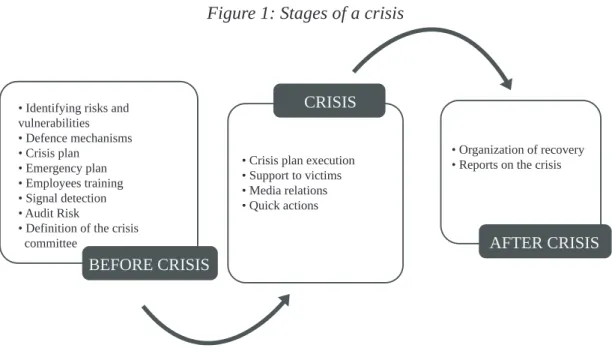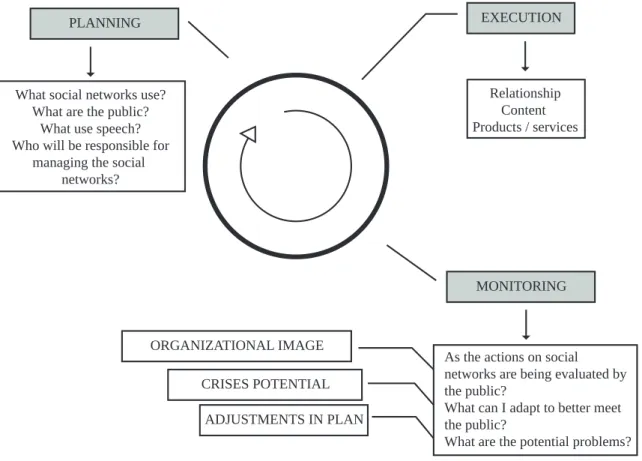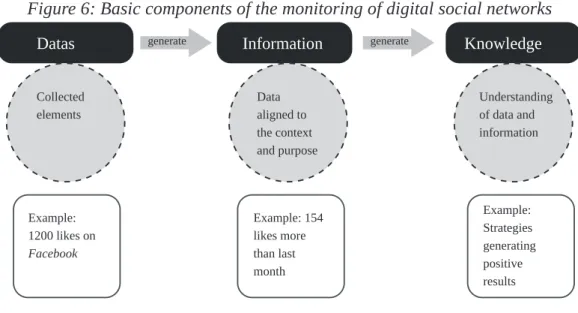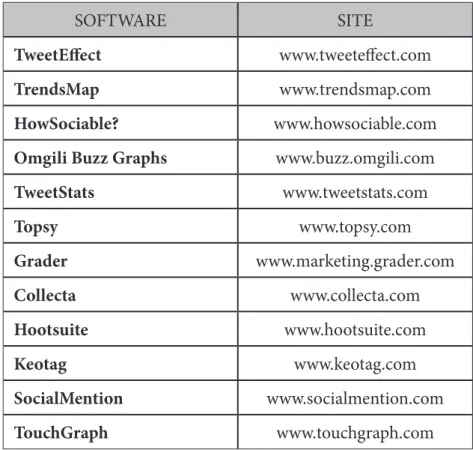DOI: 10.1590/1809-5844201616
Elisangela Carlosso Machado Mortari
(Universidade Federal de Santa Maria, Centro de Ciências Sociais e Humanas, Curso de Comunicação Social – Relações Públicas. Santa Maria – RS, Brasil)
Suzana Fernandes dos Santos
(Universidade Federal de Santa Maria, Centro de Artes e Letras, Curso de Letras – Espanhol. Santa Maria – RS, Brasil)
Abstract
This article, which refers to the organizational image crisis and digital social networks, is methodologically articulated by means of an exploratory research that focuses on understanding the strategic performance of Public Relations professional in anticipation of possible organizational image crisis by monitoring digital social networks and mutual interaction with users. Thus, after an appropriation of bibliography about concepts that based this topic, we concluded that image crisis can
be avoided through the monitoring process and the identiication of signals that show the imminence
of the crisis. In this environment, the study provides a guide to monitoring digital social networks,
which can be adapted to all types of organization and thus aid in identiication of these warning signs
preceding the crisis.
Keywords: Image. Crisis. Monitoring. Organization. Networks.
Introductin
MONITORING DIGITAL SOCIAL NETWORKS AS AN ORGANIZATIONAL STRATEGY
method provides greater familiarity with the problem as it makes more explicit and favors the enhancement of ideas.
The theoretical density associated with observation of actual cases involving image management in digital social networks allows identifying and testing resources for monitoring organizations in the digital environment. Facing this situation, the study aims to understand how crises are formed, how they reach the organizational image and how crisis situations are enhanced by digital social networks. Also seeks to understand what is the best way to carry out a social networks monitoring and indicate solutions to reverse possible crises identiied by the monitoring system.
Following this framework, it is observed that contemporary society is at a point where the Communication presence made strategically and directed arises in a steady appreciation space with organizations, whether they are small, medium or large. The certainty of an organization governed by ethics, commitment and transparency is key to consumers in such competitive times as the present. But what are organizations seeking when they invest in Communication? How Public Relations, through Communication mechanisms, can aid in optimal organizational image consolidation? These questions are guided by the logic of visibility, control and production of content which circulate in environments often little known by the Communication managers in organizations.
Participation in the digital and virtual space as a strategic action does not guarantee positive results to the organization’s image. Interactive features triggered by interacting public in these areas can lead to a disaster if the organization does not have control mechanisms. This is because organizations are not inished and immutable units, but a body susceptible to changes and adjustments as is society itself. Being the organization an open system it is permanently changing material, energy and information with the environment, affecting it with its decisions and being affected. In this way it is possible to understand the evolution of Communication in organizations and their adaptation to the social, political and economic contexts it belongs to.
organizations not only Marketing and selling actions, but the relationship and trust between organization and public, in other words, a process of planned and strategic Communication.
Currently, organizational Communication needs to be planned, since planning is a key factor in actions involving Communication and Public Relations. Joining a particular network is not enough when its goals, content and frequency are not stablished for example. This is a complex understanding about what the organization expects of the network and that the network and its stakeholders expect from its organization in the network.
For Forni (2013), if an organization is not inserted in the digital environment is like it is incomplete, or any organization outside of social networks can be considered external to the current world. However, organizations have a much larger role in digital social networks than just creating a fanpage / or proile. We need to be aware that social networks are so called for their need for interaction, relationships and creating bonds.
Crisis and network Communication
Considering the importance of consolidating a positive image and also a good reputation in the current competitive environment, being aware about the vulnerabilities which the organization are exposed to is determinative, since critical events involving the organization name can put at stake the credibility of an institution. Plane crashes, contaminated food, natural and environmental disasters and irregular labor exploitation are some things that happen frequently, exposing the organization and leaving a shaky image with its public. In 1982, extra strong Tylenol capsules, manufactured by Johnson & Johnson, were contaminated with cyanide, killing seven people in the United States; in 1998, a allotment of Microvlar contraceptive containing lour, manufactured by Schering do Brasil, was sold by mistake; the occurrence of plane crashes, as the TAM light 3054 in 2007, with 199 deaths, and the Air France light 447 in 2009, accounting for 228 deaths; the oil spill in the Gulf of Mexico, due to the explosion of a British Petroleum platform in 2010; in 2011, allotments of Toddynho chocolate milk, manufactured by PepsiCo, were sold with remnants of cleaning products; the typhoon that hit Philippines in 2013 and left about 10.000 dead and 2.000 missing are just a few of the situations of many types, which often occur, bringing concern and apprehension to the institutions involved. These episodes, which occur suddenly and cause great damage, are called Organizational Crisis.
MONITORING DIGITAL SOCIAL NETWORKS AS AN ORGANIZATIONAL STRATEGY
our translation) says it is “a speciic, unexpected and unprecedented event or series of events that creates high levels of uncertainty and threatens or are perceived as threats to the organization’s goals”. Argenti (2006, p. 259, our translation) talks about the tangible and intangible damage of the crisis through a very simple deinition:
the crisis is a serious disaster that can occur naturally or as a result of human error, intervention or even criminal intent. May include tangible devastation, the destruction of lives or assets, or intangible devastation, as the loss of credibility of the organization or other reputation damages. The latter results may be a consequence of the management response to the tangible devastation or results of human error.
An organizational crisis is any and all generally unexpected occurrence, that when not managed properly can achieve great proportions, escape the control of managers and gain visibility in the Media, compromising the organizational image. Ulmer et al (2007) says that there are three unique factors that differentiate a crisis from any other event: the surprise, the threat and the short response time. These studies indicate that what differentiates the event and conigures it as a crisis are its unexpected way to happen, requiring accurate and concrete actions, the threat that causes to the organization through tangible and intangible aspects and the requirement for a short time for answers and explanations of those involved. The crises, despite being conigured by the same general characteristics, occur for distinct reasons, and have different sources and are triggered in various situations. These particular features of each crisis allow them to be classiied according to their type, taking into account that not all crises have the same nature, the same gravity or generate the same impact among those involved.
Figure 1: Stages of a crisis
• Identifying risks and vulnerabilities • Defence mechanisms • Crisis plan
• Emergency plan • Employees training • Signal detection • Audit Risk
• Definition of the crisis committee
• Crisis plan execution • Support to victims • Media relations • Quick actions
• Organization of recovery • Reports on the crisis
BEFORE CRISIS
AFTER CRISIS CRISIS
Source: Prepared by the authors
Regarding the phases of the crisis, Coombs and Holladay (2010) state that when an organization exceeds the basic phases of a crisis, it begins again to enter a pre-crisis period, better prepared and able to manage with much more effectiveness in the next crisis, if it occurs. For this study will be kept the focus on the Pre-Crisis phase, in order to understand the signals in digital social networks before the crises happen to prevent further damage.
Predictability of Crises: detecting signals in networks
MONITORING DIGITAL SOCIAL NETWORKS AS AN ORGANIZATIONAL STRATEGY
Long before actually occurring, almost all crises send repeated “warning signs” announcing the likely occurrence of the crisis. If these early warning signs are identiied, ampliied and put into practice effectively, then many crises can be prevented before it occurs, what is the best way to manage a crisis. To accomplish this, organizations need to constantly scan their internal and external environment operations, in order to ind early warning signs of potential “time bombs” (latent defects) before it is too late to correct. In short, they have to stop being reactive to being continuously proactive.
With the internet and the possibility of interaction and search for online information, image crises happen almost in real time, at the same time of the event, reported instantly in networks, or even when past events come to light through social networks. The bad news resulting from intentional or unintentional failures lead to a rapid visibility, since it is highly enhanced by interest groups, stakeholders, activists and society that somehow is reached. These events are easily spread across the web and gain strength with every click.
Figure 2: Ideal cyclic process for performance of organizations in digital social networks
What social networks use? What are the public?
What use speech? Who will be responsible for
managing the social networks?
EXECUTION
As the actions on social networks are being evaluated by the public?
What can I adapt to better meet the public?
What are the potential problems? Relationship
Content Products / services PLANNING
MONITORING
ORGANIZATIONAL IMAGE
CRISES POTENTIAL
ADJUSTMENTS IN PLAN
Source: Prepared by the authors
To explain the importance of feedback related to digital social networks in order to build a positive image in the online environment, we brought some examples of well-done actions and reactions by companies on social networks.
One of the Brazilian brands that best works content in social networks, and has the recognition of its public is the Ponto Frio1. Through a penguin mascot, the repertoire of the
brand varies according to what is being said on the network, using humor to elaborate the content of the posts.
MONITORING DIGITAL S OCIAL NETWORKS AS AN ORGANIZATIONAL STRATEGY
Figure 3: Post using content circulating on digital social networks
Source: Post removed from the social networking site Twitter
As for the relationship, Schweppes2 has been very successful in the position shown
below, on the pronunciation of the brand:
About the product / service, actions like the HABIB’S3 strategies are very well
accepted by consumers and users of Digital Social Networks:
Figure 5: Relationship strategy from the customer’s post
Source: Post removed from the social networking site Twitter.
Russell and Rose (2012, p. 273, our translation) argue that “interacting ethically and responsibly adds positive results in both the organizational image and their relationships”
MONITORING DIGITAL SOCIAL NETWORKS AS AN ORGANIZATIONAL STRATEGY
in networks. In addition, a strategic management can identify trends and dissatisfaction, in addition to prevent conlicts.
Monitoring networks for crises prevention
The term “to monitor” expresses the meaning of following, observing events regarding of a given object in a certain geographic space and time. Applied to the area of social networking, monitoring has a very consistent and broad deinition. Thus, we will bring some knowledge on the implementation of this activity on the online environment in order to give a broader understanding of the subject.
According to PaperCliQ, the monitoring of digital social networks “is the collection, storage, classiication, categorization, addition of information and analysis of public online mentions” of terms and pre-deined issues, for a given organization.
Through monitoring the organization of the public in the network can be known and, by this, it is possible to identify market trends that can generate strategic insights. It also enables numbers and indicators that validate or invalidate a given strategy and enables the identiication of how the organization is perceived in social networks. Such monitoring, if carried out in an investigative and preventive way, helps to identify signals on the organizational image and reputation, identifying image crises to come.
E-life also concluded that monitoring is not just a strategy, but also has the function of a real time thermometer, which allows to measure the satisfaction level of the public, meet their needs and also to predict possible crises through constant analysis of their feelings shared on the network.
Figure 6: Basic components of the monitoring of digital social networks
Example: 1200 likes on
Facebook Collected elements generate generate Data aligned to the context and purpose Understanding of data and information Example: 154 likes more than last month Example: Strategies generating positive results
Datas Information Knowledge
Source: Prepared by the authors
Referring to Figure 6, we see that data, when ordinated and organized, allow us to obtain information, and this information, when interpreted, bring the knowledge of what we seek.
As for his typology, monitoring has some variables, which can be deined according to the organization and also according to its objectives and needs. Thus, we observe two types of monitoring, which are classiied according to the needs and objectives that it aims to achieve. They are:
• Full monitoring – tools that perform all the steps and that are not restricted to data collection and information classiication. A single platform performs the various stages of the process. Most of the time, these are paid software.
• Partial monitoring – tools that enable advanced data processing, that means, perform only one or the other part of the process, not the complete process, as full monitoring does. Most partial monitoring platforms are available for free.
MONITORING DIGITAL SOCIAL NETWORKS AS AN ORGANIZATIONAL STRATEGY
Figure 7: Monitoring Software digital social networks
SOFTWARE SITE
TweetEfect www.tweetefect.com
TrendsMap www.trendsmap.com
HowSociable? www.howsociable.com
Omgili Buzz Graphs www.buzz.omgili.com
TweetStats www.tweetstats.com
Topsy www.topsy.com
Grader www.marketing.grader.com
Collecta www.collecta.com
Hootsuite www.hootsuite.com
Keotag www.keotag.com
SocialMention www.socialmention.com
TouchGraph www.touchgraph.com
Source: Prepared by the authors
Step 1 – Brieing
The irst stage of monitoring digital social networks is the Brieing, which can be deined as a set of necessary information to do a certain job, in other words, it is the data that allow us to perform a strategic planning. To plan monitoring is necessary to deine some basic points:
1. What are the objectives of the monitoring? What does the organization want to achieve with the monitoring? Does it aim to predict crises? Does it want to know what the market trends are? Does it intend to evaluate the performance of an online campaign on social networks?
2. What are the social networks that will be monitored? Which social networks is the organization in? Which one do you want to monitor? Some digital social networks for speciic purposes generate beneits for certain organizations. For example, Instagram and Pinterest cannot be excluded from the list of networks to be monitored by a store that sells clothes and accessories due to their visual character. The same occurs to Foursquare when it comes to restaurants and bars looking to learn more about their public, and YouTube, which can lead to satisfactory results when monitored by audio and video producer, for example.
3. Who is responsible for implementing the monitoring? Who will be responsible for carrying out the activities related to monitoring? An internal professional of the organization or a third party company? Regardless of the choice of an internal or external professional, the people responsible for the activities must have investigative proile, strategic vision and know eficient methodologies, and have analytical skills to structure, correlate, classify and analyze the data and information obtained. It is essential that the monitoring manager is able to pass the information and knowledge acquired to the other members of the organization for making decisions.
4. What is the research object of the monitoring? The research object is the element to be searched and monitored: the organization, the brand, the competition, the public, the product, a campaign, a problem that can generate crisis?
5. What are the key words that will be used? Having deined the object of research, one must know the terms that will be searched. It is important to identify related terms, hashtag, abbreviations and acronyms, and add new terms to the search whenever these are identiied.
MONITORING DIGITAL SOCIAL NETWORKS AS AN ORGANIZATIONAL STRATEGY
Step 2 – Data Collection
What is the method used to collect data? One of the biggest dificulties of professionals of social networks monitoring is working with the large amount of data available and to deciding what should be relevant. Therefore, in some types of monitoring, samples can be used to collect data in order to facilitate the work and obtain satisfactory results. But when we seek signals identifying embryonic crises, it is best to avoid the use of samples. According to the e-book provided by BuzzMonitor, when the purpose of monitoring is to detect crises, working with samples is not advised because of the risk of critical points being unnoticed or evennot being included in the analyzed testimonies.
In monitoring aimed at identifying possible crises, the Census Collection, as deined by BuzzMonitor is the best option. This collection method allows you to consult all the individuals who are part of the focus of interest, and allows the observation of testimonies shortly after their publication, building a quite updated framework and no error percentage.
Step 3 – Metrics
As well as other stages of monitoring, metrics must be related to the objectives of the process and can change over the years and with the introduction of new platforms in the online environment. The metrics listed below are some of the ones that passed through little change, but can be adapted according to the pursued objective. The deinition of the metrics is critical in the process since an error in this step may be binding in any evaluation.
Regarding the monitoring aimed at identifying image crises, the metrics exempliied below can be of great importance and may assist in the identiication process.
• Inluencers Metric: it is related to users with greater inluence in social networks and enables the identiication of inluencers among the organization’s connections. As inluencers we mean supporters, detractors, or simply the opinion makers on a particular organization, which means people who talk about the topic searched. This category also can monitor what we call lags. As lags, we understand the proiles that are always connected and have posts regarding trends, as the case of Ponto Frio, previously shown. If these lag proiles mention or even ironically speak about a certain brand or product it is because it suffers some sort of potential problem (risk).
• Satisfaction Metrics: refers to users’ satisfaction as regarding the quality of the service offered by the company and other online factors as well as the doubts resolved.
• Metric of Themes and Topics: identiies the themes or issues related to organization, whether favorable or unfavorable, that were more or less mentioned during the deined period.
• Proile Metrics and Public Location: linked to public analysis and segmentation
of the target group, where it is located, what are their demographic data.
• Market Trends metrics: related to the understanding of the market in order to improve products and services, analyzing preferences and suggestions of its effective and potential public, thereby generating strategic insights.
Step 4 – Data Rating
After processing the metrics, we sought to interpret them according to a classiication in order to organize the data collected so that it is possible to cross them and get the information displayed. Vieira (2012) says that, in most cases, the data have four categories:
• Positive: represented by praises to the organization, its products, services and also for referrals.
• Negatives: comments or complaints about the organization, products and services.
• Neutral: do not present a value judgment, generally news or questions.
MONITORING DIGITAL SOCIAL NETWORKS AS AN ORGANIZATIONAL STRATEGY
Step 5 – Data Analysis
Data analysis is the last and most important stage of monitoring online social networks because it will generate knowledge so that actions can take place. At this stage, also according to the objectives of each organization, all data collected during the process will be interpreted, transformed into knowledge, which are organized in the report. The results will guide the future actions of the organization, as well as the next planning, which is why monitoring is considered a process.
Figure 9: Process of monitoring digital social networks
Briefing Collect Metric Classification Analysis
Source: Prepared by the authors
Figure 9 illustrates in a cyclical manner the essential steps that must be followed for any monitoring which can be conplemented and adapted according to the organizational objectives. Thus, we see clearly that the analysis of monitoring is what provides basis and guides to the next steps and continues the process, in other words, the knowledge gained generates feedback to the procedure itself.
Through monitoring the digital social networks we sought to ind ways to avoid and prevent crises warning signs to be strengthened and spread, generating speciic crises. This is where many organizations are in doubt. How to prevent potential crises? Is there a metric formula that shows the way to prevent crises?
References
ARGENTI, P. A comunicação empresarial – a construção da identidade, imagem e reputação. Rio de Janeiro: Campus, 2006.
COOMBS; W.T.; HOLLADAY S. J.The hand book of crisis communication. Oxford: Wiley-Blackwell, 2010.
COUTINHO, M. Marketing e comunidades digitais: do discurso ao diálogo. Revista da ESPM, São Paulo, v.14, n.2, p.28-39. 2007. Available at: <http://www.ideiacom.com.br/gerenciador/arquivos/ documentos /artigo_marcelo_coutinho.pdf>. Consulted on: April 16, 2014.
FERRER, J. La comunicacion en la empresa. Barcelona: Cuadernos de Comunicacion, 2000.
FORNI, J. J. Gestão de crises e comunicação. São Paulo: Atlas, 2013.
GIL, A. C. Como elaborar projetos de pesquisa. 4.ed. São Paulo: Atlas, 2002.
MENDES, A. M.; PEREIRA, F. C.; CUNHA, M. P.; SOARES, J. V.; DOS SANTOS, R. R.; PIMENTEL, I. et al. Crises de ameaças a oportunidades: gestão estratégica de comunicação de crises. Lisboa: Edições Silabo, 2006.
RUSSEL, R.; ROSA, R. Redes sociais e os desaios das organizações: um olhar nos twitter da
Natura, da Vivo e do Submarino. In: Redes Sociais, comunicação e organizações. OLIVEIRA, I. L.; MARCHIORI, M. (Org.). São Caetano do Sul: Difusão, 2012.
ULMER, R. R.; SELLNOW, T. L.; SEEGER, M. W. Effective crisis communication: moving from crisis to opportunity.Califórnia: SagePublications, 2007.
MONITORING DIGITAL SOCIAL NETWORKS AS AN ORGANIZATIONAL STRATEGY
Elisangela Carlosso Machado Mortari
PhD in Communication and Culture from the Universidade Federal do Rio de Janeiro (UFRJ). Master in Communication and Culture from the Universidade Federal do Rio de Janeiro (UFRJ). Associate Professor of the Department of Communication Sciences at the Federal University of Santa Maria (UFSM). Coordinator of the Experimental Agency of Public Relations of the Federal University of Santa Maria (UFSM). Researcher in image management area and organizational crises. Email: elimortari@gmail.com
Suzana Fernandes dos Santos
Graduated in Public Relations from the Federal University of Santa Maria (UFSM), is professional Public Relations in the company CNA Languages Santa Maria / RS. Graduation student in the course of Letters – Spanish / UFSM. Collaborator at the Research Group in Image Management and Organizational Crises. Email: suzanarrpp@gmail.com
Received on: 06.30.2015






